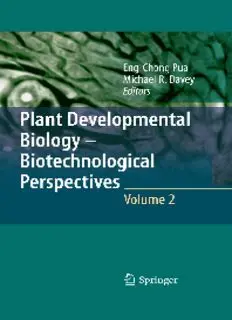
Plant Developmental Biology - Biotechnological Perspectives: Volume 2 PDF
Preview Plant Developmental Biology - Biotechnological Perspectives: Volume 2
Plant Developmental Biology - Biotechnological Perspectives: Volume 2 ‐ Eng Chong Pua Michael R. Davey l Editors Plant Developmental Biology - Biotechnological Perspectives Volume 2 Editors Prof.Dr.Eng-ChongPua Dr.MichaelR.Davey NewEraCollege Divisionof PlantandCropSciences JalanBukit SchoolofBiosciences 43000Kajang UniversityofNottingham Selangor SuttonBonington Malaysia LoughboroughLE125RD [email protected] UK [email protected] ISBN978-3-642-04669-8 e-ISBN978-3-642-04670-4 DOI10.1007/978-3-642-04670-4 SpringerHeidelbergDordrechtLondonNewYork LibraryofCongressControlNumber:2009932129 #Springer-VerlagBerlinHeidelberg2010 Thisworkissubjecttocopyright.Allrightsarereserved,whetherthewholeorpartofthematerialis concerned,specificallytherightsoftranslation,reprinting,reuseofillustrations,recitation,broadcasting, reproductiononmicrofilmorinanyotherway,andstorageindatabanks.Duplicationofthispublication orpartsthereofispermittedonlyundertheprovisionsoftheGermanCopyrightLawofSeptember9, 1965,initscurrentversion,andpermissionforusemustalwaysbeobtainedfromSpringer.Violations areliabletoprosecutionundertheGermanCopyrightLaw. Theuseofgeneraldescriptivenames,registerednames,trademarks,etc.inthispublicationdoesnotimply, evenintheabsenceofaspecificstatement,thatsuchnamesareexemptfromtherelevantprotectivelaws andregulationsandthereforefreeforgeneraluse. Coverdesign:WMXDesignGmbH,Heidelberg,Germany Printedonacid-freepaper SpringerispartofSpringerScience+BusinessMedia(www.springer.com) Preface Many exciting discoveries in recent decades have contributed new knowledge to our understanding of the mechanisms that regulate various stages of plant growth and development. Such information, coupled with advances incelland molecular biology,isfundamentaltocropimprovementusingbiotechnologicalapproaches. Two volumes constitute the present work. The first, comprising 22 chapters, commences withintroductions relating togeneregulatorymodels forplantdevel- opmentandcropimprovement,particularlytheuseofArabidopsisasamodelplant. Thesechaptersarefollowedbyspecifictopicsthatfocusondifferentdevelopmental aspects associated with vegetative and reproductive phases of the life cycle of a plant. Six chapters discuss vegetative growth and development. Their contents consider topics such as shoot branching, bud dormancy and growth, the develop- ment of roots, nodules and tubers, and senescence. The reproductive phase of plant development is in 14 chapters that present topics such as floral organ initia- tionandtheregulationofflowering,thedevelopmentofmaleandfemalegametes, pollen germinationand tube growth,fertilization,fruit development andripening, seed development, dormancy, germination, and apomixis. Male sterility and self-incompatibility are also discussed. Volume 2 has 20 chapters, three of which review recent advances in somatic embryogenesis, microspore embryogenesis and somaclonal variation. Seven of the chapterstargetplantprocessesandtheirregulation,includingphotosynthatepartition- ing,seedmaturationandseedstorageproteinbiosynthesis,theproductionandregula- tion of fatty acids, vitamins, alkaloids and flower pigments, and flower scent. This second book also contains four chapters on hormonal and environmental signaling (aminocompounds-containinglipids,auxin,cytokinin,andlight)intheregulationof plantdevelopment;othertopicsencompassthemoleculargeneticsofdevelopmental regulation,includingRNAsilencing,DNAmethylation,epigenetics,activationtag- ging,homologousrecombination,andtheengineeringofsyntheticpromoters. Thesebookswillserveaskeyreferencesforadvancedstudentsandresearchers involved in a range of plant-orientated disciplines, including genetics, cell and molecularbiology,functionalgenomics,andbiotechnology. August2009 E-C.PuaandM.R.Davey v Contents PartI CellDifferentiationandDevelopmentInVitro 1 DevelopmentalBiologyofSomaticEmbryogenesis .................... 3 R.J.Rose,F.R.Mantiri,S.Kurdyukov,S-K.Chen,X-D.Wang, K.E.Nolan,andM.B.Sheahan 1.1 Introduction ............................................................ 3 1.2 BasicRequirementsforInVitroSE ................................... 4 1.3 ExplantandStemCellBiology ....................................... 5 1.3.1 Genotype ........................................................ 5 1.3.2 ExplantCells .................................................... 6 1.4 EarliestEventinEmbryogenesis—AsymmetricCellDivision ....... 8 1.4.1 CellWallinEstablishmentofPolarity,DivisionAsymmetry andCellFate .................................................... 8 1.4.2 DivisionAsymmetryintheInitiationofSE ................... 10 1.4.3 AsymmetricDivisionandtheSuspensorinSE ............... 10 1.5 StressComponentintheInitiationofSE ............................ 11 1.5.1 ReactiveOxygenSpecies ...................................... 11 1.5.2 Stress-RelatedHormoneSignalling ........................... 12 1.6 HormonesandtheInitiationofSE ................................... 13 1.7 InductionofSEbyOver-ExpressionofLeafyCotyledon TranscriptionFactorsandTheirRelationshiptoSEInductionand Repression—theGAConnection ..................................... 14 1.8 ABA,StressandGA .................................................. 16 1.9 SolubleSignalsandCell–CellInteractionsthatPromoteSEin SuspensionCultures .................................................. 16 1.9.1 SecretedProteinsthatInfluenceSE ........................... 16 1.9.2 AGPSignallinginSE:MechanismsandInteractionsBetween SignallingPathways ........................................... 17 1.9.3 Cell–CellInteractionandRelevancetoSEinSuspension Cultures ........................................................ 18 vii viii Contents 1.10 DevelopmentProgramAfterSEInduction ......................... 19 1.11 ConcludingRemarksandaModelBasedonStudiesin Medicagotruncatula ................................................ 19 1.12 SEandBiotechnology ............................................... 20 References ................................................................. 21 2 MicrosporeEmbryogenesis ............................................. 27 A.Olmedilla 2.1 Introduction ........................................................... 27 2.2 DiscoveryoftheProductionofHaploidsbyAntherCulture ........ 29 2.3 StrategiesfortheInductionofMicrosporeEmbryogenesis ......... 29 2.4 InfluenceofDifferentFactorsinMicrosporeEmbryogenesis ....... 30 2.4.1 Genotype ....................................................... 30 2.4.2 DonorPlantPhysiology ....................................... 31 2.4.3 StageofPollenDevelopment .................................. 31 2.4.4 Pre-treatments .................................................. 32 2.4.5 CultureConditions ............................................. 32 2.4.6 CompositionoftheMedium ................................... 33 2.5 CellularandMolecularEventsAssociatedwithMicrospore Embryogenesis ........................................................ 34 2.5.1 EmbryogenicInduction ........................................ 34 2.5.2 EarlyEmbryogenicDivisions ................................. 37 2.5.3 DevelopmentofEmbryoPattern .............................. 38 2.5.4 PlantFormationandDiploidization ........................... 39 2.6 Conclusions ........................................................... 39 References ................................................................. 40 3 StressandSomaclonalVariation ....................................... 45 A.M.Va´zquezandR.Linacero 3.1 Introduction ........................................................... 45 3.2 StressResponsesinPlants ............................................ 46 3.2.1 Short-TermResponses ......................................... 46 3.2.2 Long-TermResponses ......................................... 47 3.2.3 ModificationsInducedbyStressCouldBeInheritable ....... 49 3.3 TissueCultureImposesaStresstoCultivatedInVitroCells ....... 50 3.4 CulturedCellsandRegeneratedPlantsShowVariations ............ 52 3.4.1 HeritableChangesVersusNon-HeritableChanges ........... 54 3.4.2 GeneticVersusEpigeneticChanges ........................... 55 3.4.3 VariationPromotedbyTissueCultureisNotRandomly DistributedintheGenome ..................................... 57 3.4.4 AreNewAllelesOriginatedbyInVitroStressAlready PresentinOtherPlantsofInVivoPopulations? .............. 58 3.5 ConcludingRemarks .................................................. 58 References ................................................................. 58 Contents ix PartII PlantProcessesandTheirRegulation 4 PhotosynthatePartitioning ............................................... 67 N.G.Halford 4.1 Introduction ........................................................... 67 4.2 SourceandSink ...................................................... 69 4.3 SugarsasSignallingMolecules ...................................... 69 4.4 KeyMetabolicRegulators ............................................ 70 4.4.1 SNF1-RelatedProteinKinase1(SnRK1) ..................... 70 4.4.2 Hexokinase ..................................................... 74 4.4.3 TheTrehalosePathway ........................................ 74 4.5 ApplicationsinBiotechnology ....................................... 75 4.6 ConcludingRemarks ................................................. 79 References ................................................................. 80 5 MolecularPhysiologyofSeedMaturationandSeedStorage ProteinBiosynthesis ..................................................... 83 H.Weber,N.Sreenivasulu,andW.Weschke 5.1 Introduction ........................................................... 83 5.2 SeedMaturation ...................................................... 84 5.3 SucroseasaMaturationSignal ...................................... 85 5.4 SynthesisandDepositionofStorageProteinsinCropSeeds ....... 86 5.5 StorageProteinsinCereals ........................................... 87 5.5.1 StorageProteinsintheDifferentGrainParts ................. 87 5.5.2 TranscriptionalRegulationofArabidopsisSeedMaturation ... 89 5.5.3 TranscriptionalRegulationofArabidopsisSeedMaturation—a ModelAlsoforCerealSeeds? ................................. 89 5.5.4 UnravellingTranscriptionalRegulationbyCo-Expression Analysis ........................................................ 90 5.5.5 DNAMethylationandStorageProteinGeneExpressionin theBarleyEndosperm ......................................... 92 5.6 MetabolicControlofSeedStorageProteinSynthesis ............... 93 5.6.1 NitrogenAvailabilityandSignalling .......................... 93 5.6.2 CarbonAvailability ............................................ 96 5.7 Outlook ............................................................... 98 References ................................................................. 99 6 FattyAcidBiosynthesisandRegulationinPlants .................... 105 R.RajasekharanandV.Nachiappan 6.1 Introduction ......................................................... 105 6.2 FattyAcidBiosynthesis ............................................. 106 6.2.1 DeNovoFattyAcidBiosynthesis ............................ 106 6.2.2 RegulationofACCase ........................................ 108 6.3 FattyAcidElongation ............................................... 109 x Contents 6.4 FattyAcidDesaturation ............................................. 110 6.5 UnusualFattyAcids ................................................ 110 6.6 AssemblyofFattyAcids ............................................ 111 6.7 Conclusions ......................................................... 112 References ................................................................ 112 7 BiosynthesisandRegulationofCarotenoidsin Plants—Micronutrients,VitaminsandHealthBenefits ............. 117 C.I.Cazzonelli,N.Nisar,D.Hussain,M.E.Carmody,andB.J.Pogson 7.1 Introduction:CarotenoidBiosynthesisinHigherPlants ........... 117 7.2 CarotenoidsandPlantDevelopment ................................ 121 7.3 HealthBenefitsofCarotenoid-DerivedVitaminsandNutrients ... 123 7.3.1 Zeaxanthin,LuteinandPreventionofMacular Degeneration .................................................. 125 7.3.2 b-CaroteneandtheBiosynthesisofVitaminA .............. 126 7.3.3 AntioxidantPropertiesofOtherXanthophylls andXanthophyllDerivatives ................................. 129 7.4 ConclusionsandFutureProspects .................................. 130 References ................................................................ 130 8 BiosynthesisandRegulationofAlkaloids ............................. 139 G.Guirimand,V.Courdavault,B.St-Pierre,andV.Burlat 8.1 Introduction ......................................................... 139 8.2 ChemicalDiversityandBiosynthesis ............................... 140 8.2.1 BiosynthesisofMonoterpeneIndoleAlkaloids(MIA) ...... 140 8.2.2 BiosynthesisofBenzylisoquinolineAlkaloids(BIA) ........ 147 8.2.3 BiosynthesisofTropaneandNicotineAlkaloids(TNA) .... 147 8.2.4 BiosynthesisofPurineAlkaloids(PA) ....................... 148 8.3 SpatialOrganisationofAlkaloidBiosynthesis ..................... 148 8.3.1 CrystallisationandThree-DimensionalStructureofAlkaloid BiosyntheticEnzymes ........................................ 152 8.3.2 TranscriptionFactorRegulatoryNetworksofAlkaloid Biosynthesis ................................................... 153 8.3.3 MetabolicEngineeringofAlkaloidBiosynthesis ............ 154 8.4 Conclusions ......................................................... 155 References ................................................................ 156 9 MolecularBiologyandBiotechnologyofFlowerPigments .......... 161 K.M.DaviesandK.E.Schwinn 9.1 Introduction ......................................................... 161 9.2 PigmentBiosyntheticPathwaysandTheirGeneticModification .... 162 9.2.1 Flavonoids .................................................... 162 9.2.2 Carotenoids ................................................... 167 9.2.3 Betalains ...................................................... 173 Contents xi 9.3 RegulationofFloralPigmentation .................................. 175 9.3.1 TranscriptionalControl ....................................... 176 9.3.2 DevelopmentalSignalling .................................... 178 9.3.3 BiotechnologyApplicationsofTFs .......................... 179 9.4 ConcludingComments .............................................. 180 References ................................................................ 181 10 BiosynthesisandRegulationofFlowerScent ......................... 189 B.PiechullaandU.Effmert 10.1 Introduction ........................................................ 189 10.2 FunctionsofFloralScents ......................................... 190 10.2.1 FloralScentsforPollination ............................... 190 10.2.2 FloralScentswithDiverseFunctions ..................... 190 10.3 PatternsofFloralEmission ........................................ 191 10.4 BiosyntheticPathwaysandKeyEnzymes ........................ 193 10.4.1 Terpenoids ................................................. 194 10.4.2 BenzenoidsandPhenylpropanoids ........................ 194 10.4.3 AliphaticCompounds ...................................... 195 10.5 RegulationofFloralVolatileBiosynthesis ........................ 196 10.5.1 RegulationattheMolecularLevel ........................ 196 10.5.2 MechanismsofRegulation ................................ 197 10.6 BiotechnologicalAspects .......................................... 198 10.7 Conclusions ........................................................ 201 References ................................................................ 201 PartIII HormonalandEnvironmentalSignalling 11 AminoCompound-ContainingLipids:aNovelClassofSignals RegulatingPlantDevelopment ......................................... 209 R.Ortiz-Castro,A.Me´ndez-Bravo,andJ.Lo´pez-Bucio 11.1 Introduction ........................................................ 209 11.2 BiosynthesisandMetabolismofAcylamidesinPlants ........... 210 11.3 DistributionofAcylamides ........................................ 212 11.4 RoleofNAEsandAlkamidesinPlantDevelopment ............. 213 11.4.1 SeedGermination .......................................... 214 11.4.2 ShootDevelopment ........................................ 215 11.4.3 RootDevelopment ......................................... 217 11.5 SignalsInteractingwithNAEsandAlkamides ................... 218 11.5.1 Auxins ..................................................... 218 11.5.2 Cytokinins ................................................. 219 11.5.3 NitricOxide ................................................ 219 11.6 CellularAlterationsUnderlyingPlantResponsestoNAEsand Alkamides:CellCycleProgressionandMicrotubuleStability ... 220 11.6.1 CellCycleProgression .................................... 220
